4 Digital Marketing Strategy Studies: Formats, Trends, Influencers & Engagement
- Fahad H

- Feb 3, 2015
- 5 min read
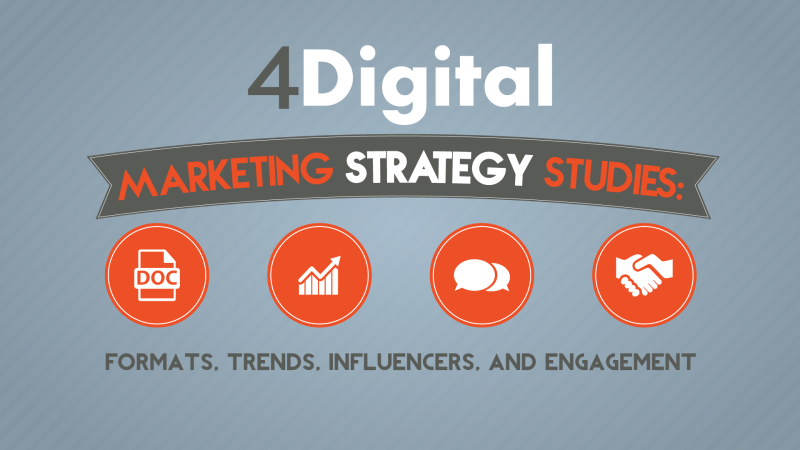
Success begins with a good plan. A good plan, in turn, begins with research to understand which solutions might offer the best outcomes for your challenges.
Four new studies have taken on answering the who, what, where, why, and when of digital marketing, giving us insights on the right solutions for brands in every vertical.
Social Content Calendar
A successful marketing effort relies on your ability to deliver the content that audiences want, when they want it.
Figuring out these two components can be challenging, so BuzzStream and Fractl (my employer) looked more closely at sharing among 11 different verticals over six months to find patterns with popular content.
Using BuzzSumo, we tracked 220,000 pieces of content in these formats: how-to articles, lists, what posts, why posts, and videos.
How-To Articles
This format peaks in October, but earns strong shares in August and November as well. How-to articles are the most successful format for the food vertical, earning 37% of all shares during our study period. How-to articles also perform strongly for the news vertical — earning a close second place — with 22% of shares.
Lists
Lists lead content sharing in the summertime. In June through August, this format earns between 17K and 24K shares consistently each month.
Lists are also the strongest content type for the health and travel vertical, and tie for most-shared format in the food vertical.
What Posts
This content type, which typically asks a question or describes an insight such as What Bartenders Actually Think of Your Drink Order, emerged as the riskiest format in our study, earning both the highest high and lowest low in social sharing over six months.
What-posts spiked with 29K shares in October with a surge in the news vertical; however, what-posts rarely received even 1K in shares in June or July.
Why Posts
Content that explains – called why-posts – is the second most-shared format and receives the most attention in the fall, earning an average of 24K shares per month in September, October, and November. Why-posts are particularly strong earners in the lifestyle vertical, accounting for 36% of overall shares.
Videos
Videos earned 27–35% of of shares in the education and entertainment verticals, but ranked last for many other verticals. Video trends may be ones to watch as both Facebook and Twitter compete for stakes in this format.
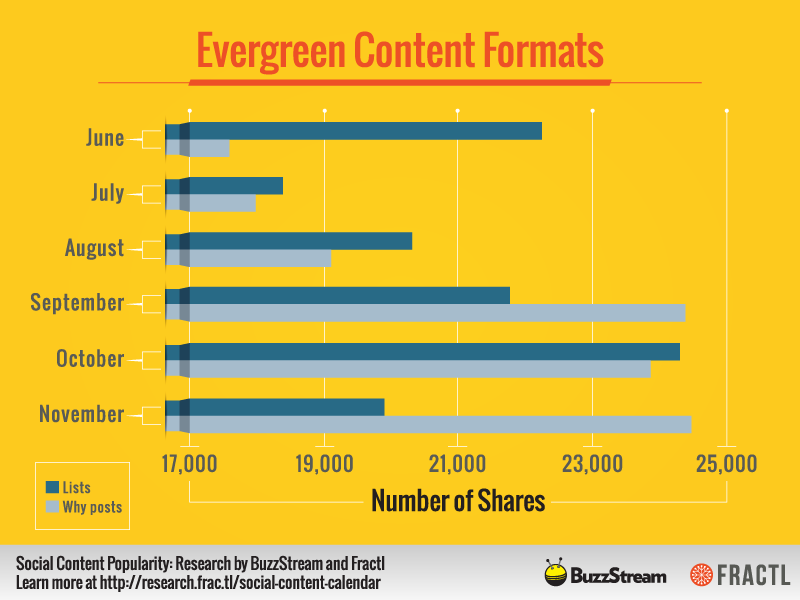
Lists and why-posts emerged as the highest performing content types overall, earning more than 20% of all shares in the dataset and 22–32% of shares in the Entertainment, News, and Travel verticals.
However, as the chart above suggests, timing plays a big role in content sharing success. For more, we’ve compiled the results by vertical, content type, and month in our Social Content Calendar.
Marketing Trend Report
Marketers are working faster than ever to keep up with the content preferences of digital audiences. A myriad of tools and options have been developed for marketers and advertisers to engage online, and we set out to see which are rising (or falling) in popularity.
Using Google Trends, BuzzStream and Fractl tracked searches for 20 key marketing terms regionally and globally. Here we share results for five terms related to online marketing strategies.

Native Advertising: The late bloomer of the bunch, native advertising didn’t earn its first blip on the marketing industry’s radar until March of 2011 and didn’t gain traction until November of the same year. Since then the term has earned a mostly positive rise, peaking in August of 2014 when it briefly surpassed the traffic volume of pay-per-click.
Content Marketing: Pay-per-click earned nine times more search interest than content marketing in January of 2008, but by the end of 2014 the roles were reversed – content marketing now leads with three times the traffic. The switch took place in November of 2012 and the gap has widened continuously ever since.
Social Media Marketing: Searches for social media marketing began in 2007, the same year that Microsoft announced its investment in Facebook. But 2009 marked the beginning of a two-year, 80% rise in interest that has kept the tactic near the top in marketing searches. Searches have fluctuated 20–30% over the past three years, but hit an all time high in April of 2014.
Landing Page Optimization: The most turbulent of trends in the marketing strategy category, landing page optimization garnered its initial and greatest gain in interest between May and June of 2008. The past seven years have been extremely inconsistent for this tactic, with searches rising and falling as much as 55% in a single month. This lack of stability is a signal that the industry has not yet adopted landing page optimization as a staple marketing approach.
Pay-Per-Click: The preferred approach at the start of 2008, searches for the phrase “pay per click” have fallen 68% over the past seven years. The acronym PPC earns more search traffic by volume – an indication of the industry’s embrace of this approach – yet searches for this abbreviation have also fallen 84% during the same time period.
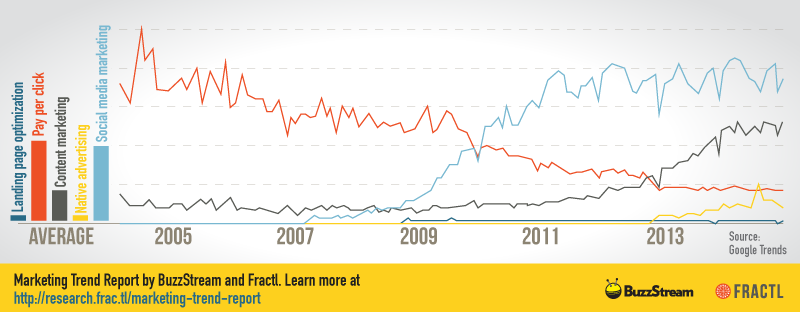
We’ve included the results for all 20 terms in our long-term global analysis and recent regional insights in our Marketing Trend Report.
The Influencer Marketing Discussion Trending On Twitter
After learning which marketing tools and tactics are being most searched, we turned to Twitter to find out what marketing influencers are saying about the industry. BuzzStream and Fractl scraped nearly 5,000 tweets that contained at least one marketing keyword or hashtag from our list:
Media Relations
Influencer Marketing
Digital PR
Outbound Marketing
Brand Recognition
Earned Media
PR
Public Relations
Publicity
Press Release
Then, we utilized Peer Index, Twitonomy, and the Alchemy API to discover the tweet types, sentiments, and key influencers in the discussion.
Marketing Conversation
We found that influencers in the marketing field appear to practice what they preach when it comes to value-added content.
At least half of all tweets in this study included helpful tips or marketing insights, including resources like Entrepreneur’s roundup of Marketing Trends Experts Want You to Avoid and Ragan’s write up on How to Avoid Journalists’ 5 Worst Pitching Peeves.
This was especially true for the emerging keywords “earned media” and “outbound marketing,” in which trends were the dominant category of tweets.
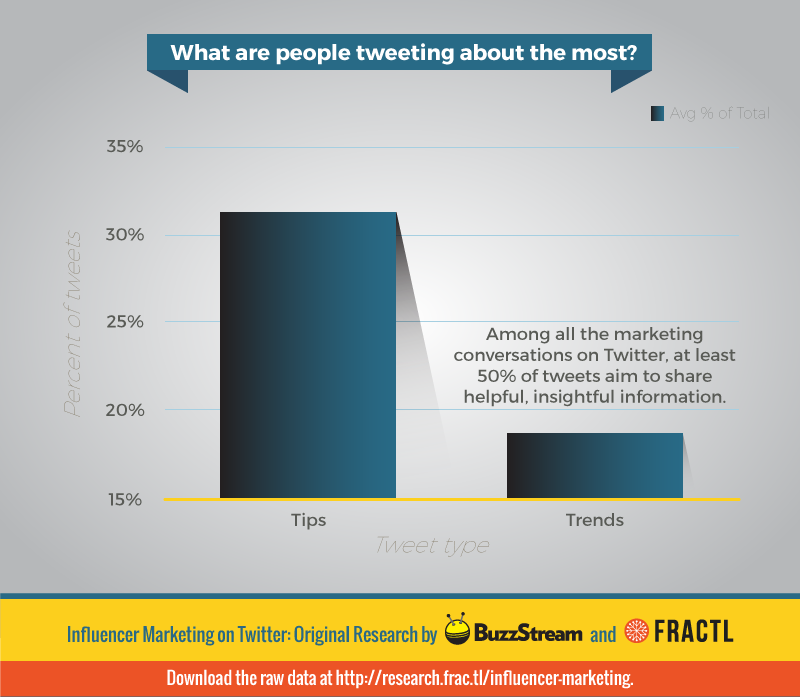
Marketing Influencers
We were surprised to discover that many of the most influential people tweeting with our marketing key terms weren’t people at all – they were brands. 52% of the top influencers we identified using Peer Index included PR teams for brands ranging from commercial companies like Nestlé and Disney, to public information groups like the Los Angeles Police Department and NPR, to industry resources like PR News and Help A Reporter Out.
Of the percentage of influencers that are individuals, at least 41% are in leadership or consulting positions. Job titles like Director, CEO, CMO, and Consultant dominated the list, followed by people in writing, blogging, and strategist roles.
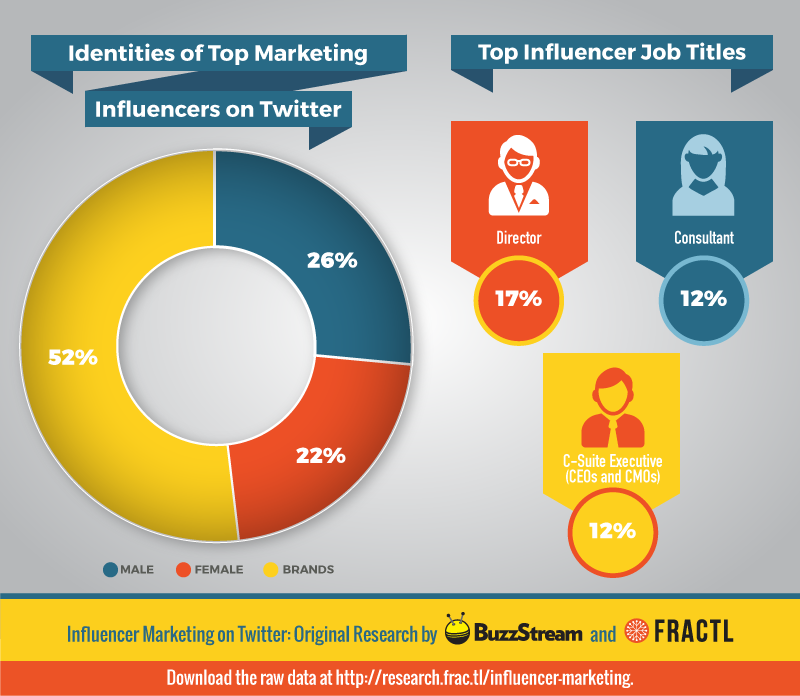
Our full dataset of tweets and influencers is available to download with our findings on Influencer Marketing.
Twitter Engagement Unmasked
Finally, a fascinating new study from Stone Temple rounds out the research that caught my eye this month. In their research on Twitter engagement, 1.94 million tweets revealed that social authority can have a great deal of influence over how various messaging tactics will engage followers.
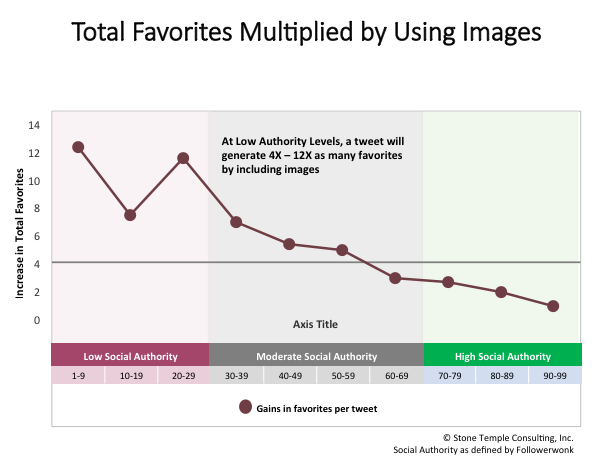
One of the most striking examples from their finding concerns the use of images. At the lowest authority levels, photos and graphics can earn up to 12X more favorites than tweets without images. Similarly, Low Authority accounts also earn the most RTs by employing images – up to 9X as many in the very lowest category.
In terms of both favorites and RTs, engagement drops off sharply for Twitter accounts in the moderate social authority range, and falls even lower for those with the highest authority.
Considering how social authority may impact your marketing strategy is an important angle, especially in light of findings that suggest that some tactics may actually hurt engagement depending on your brand’s authority position. Read the full study and findings at Twitter Engagement Unmasked.








Comments